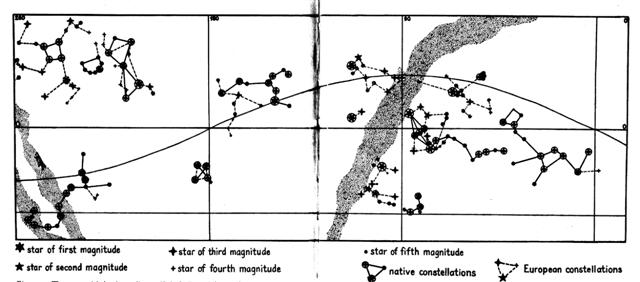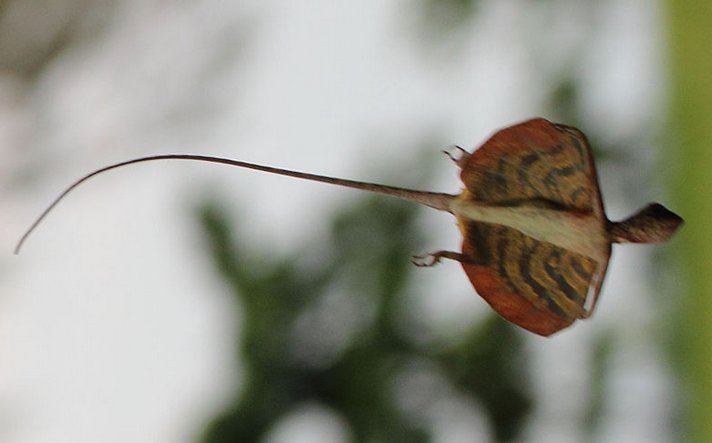439. Not only was the Milky Way running
between Orion and Gemini but here - at the time of
rongorongo - was also the right
ascension line for 6h, i.e. 11 + 80 + 92 = 183 days
after the December solstice, an extraordinary situation
which occurred only once in 26000 years. This could well
have been a reason for creating such a suitable medium
as the rongorongo texts in order to celebrate.
The sinus curve of
the ecliptic was at a maximum, with the Sun at the
top of the June solstice. Although on Easter Island it
was not the summer but the winter solstice, which could
be demonstrated by inverting the curve.
And due to the
precession the ecliptic curve (the flying serpent)
was pushed
gradually towards the east (earlier among the
constellations).
Therefore a new
year which once upon a time would have been defined by Gemini
closely before the spring equinox (north of the equator)
should at the time of rongorongo be not very far after the
June solstice. 172 (June 21) + 11 = 183 (July 2)
corresponded to December 21 + 11 = January 1.
|
erua tamaiti |
kua vaha te mago erua |
 |
 |
 |
 |
|
Ca4-26 |
Ca4-27 (78 + 25) |
Ca4-28 (104) |
Ca4-29 |
|
CLOSE TO
THE FULL MOON: |
|
July 1 (182 = 157 + 25)
τ Puppis (102.2), ψ7 Aurigae (102.4)
*61 = *102.4 - *41.4 |
2 (*103 = *78 + *25)
Mash-mashu-sha-Risū-9 (Twins of the
Shepherd)
θ Gemini (103.0), ψ8 Aurigae (103.2),
ALHENA = γ Gemini
(103.8), ψ9 Aurigae (103.9) |
3
ADARA (Virgins) = ε Canis Majoris
(104.8) |
4 (185)
ω Gemini (105.4),
ALZIRR (Button) = ξ Gemini
(105.7),
MULIPHEIN (Oaths) = γ Canis Majoris
(105.8),
MEKBUDA (Contracted) = ζ Gemini
(105.9)
*64 = *105.4 - *41.4 |
|
... Al Maisān, the title of
γ
Geminorum [Alhena], by some error of
Firuzabadi was applied to this star [Heka in
Orion] as Meissa, and is now common
for it. Al Sufi called it Al Tahāyī;
but Al Ferghani and Al Tizini knew it as
Rās al Jauzah, the Head of the Jauzah,
which it marks. The original Arabic name,
Al Hak'ah, a White Spot, was from the
added faint light of the smaller
φ¹and
φ²
in the background, and has descended to us
as Heka and Hika. These three
stars were another of the Athāfiyy
[tripods used for cooking] of the Arabs; and
everywhere in early astrology were thought,
like all similar groups, to be of
unfortunate influence in human affairs. They
constituted the Euphratean lunar station
Mas-tab-ba-tur-tur, the Little Twins, a
title also found for
γ
[Alhena] and
η
Geminorum [Tejat Prior]; and individually
were important stars among the Babylonians,
rising to them with the sun at the summer
solstice, and, with
α
and
γ,
were known as Kakkab Sar, the
Constellation of the King |
|
'June 4 (132 +
23) |
5 (156) |
6 (314 / 2) |
7 |
|
"May 21 (118 + 23) |
22 (142 = 156 - 14) |
23 |
24 (12 * 12) |
|
APRIL 28 (95 + 23) |
29 (119 = 156 - 37) |
30 |
MAY 1 (11 * 11) |
|
MARCH 2 (38 + 23) |
3 (62 = 183 - 121) |
4 |
5 (8 * 8) |
|
4 |
kua iri i te rakau |
ihe tamaiti |
erua mago |
|
Iri.
1. To go up;
to go in a boat on the sea (the surface
of which gives the impression of going
up from the coast): he-eke te tagata
ki ruga ki te vaka, he-iri ki te
Hakakaiga, the men boarded the boat
and went up to Hakakainga. 2.
Ka-iri ki puku toiri ka toiri.
Obscure expression of an ancient curse.
Vanaga. Iri-are, a seaweed.
Vanaga. |
 |
 |
 |
 |
|
Ca5-5 |
Ca5-6 (111) |
Ca5-7 (78 + 34) |
Ca5-8 |
|
CLOSE TO THE FULL MOON: |
|
July 9
no star listed (110) |
10
ALUDRA (Virgin) = η Canis Majoris
(111.1),
PROPUS = ι Gemini
(111.4),
GOMEISA (Water-eyed) = β Canis Minoris
(111.6)
*70 = *111.4 - *41.4 |
11 (*112)
ρ Gemini (112.1),
Eskimo Nebula = NGC2392 Gemini
(112.2)
ANTARES (α
Scorpii)
|
12 (193)
Al Dhirā'-5 (Forearm)
/
Punarvasu-7 /
Mash-mashu-Mahrū-10 (Western One of the
Twins)
CASTOR = α Gemini
(113.4)
*72 = *113.4 - *41.4 |
|
... In Hindu legend there was a mother
goddess called Aditi, who had
seven offspring. She is called 'Mother
of the Gods'. Aditi, whose name
means 'free, unbounded, infinity' was
assigned in the ancient lists of
constellations as the regent of the
asterism Punarvasu. Punarvasu
is dual in form and means 'The
Doublegood Pair'. The singular form of
this noun is used to refer to the star
Pollux. It is not difficult to surmise
that the other member of the Doublegood
Pair was Castor. Then the constellation
Punarvasu is quite equivalent to
our Gemini, the Twins. In far antiquity
(5800 BC) the spring equinoctial point
was predicted by the heliacal rising of
the Twins ... |
|
'June 12 |
13 (164 = 191 - 27) |
14 (*85) |
15 |
|
"May 29 |
30 (150 = 191 - 41) |
31 (*71) |
"June 1 |
|
MAY 6 |
7 (127 = 191 - 64) |
8 (*48) |
9 |
|
MARCH 10 |
11 (70 = 191
- 121) |
12 (*357 = 366 + 71 - 80) |
13 |
|
te hokohuki erua |
te marama |
 |
 |
 |
|
Ca5-9 |
Ca5-10 (115) |
Ca5-11 |
|
CLOSE TO THE FULL MOON: |
|
ANA-TAHUA-VAHINE-O-TOA-TE-MANAVA-7
(Pillar for elocution)
July 13
υ Gemini (114.0),
MARKAB PUPPIS = κ Puppis
(114.7), ο Gemini (114.8),
PROCYON = α Canis Minoris
(114.9) |
14
α Monocerotis (115.4), σ Gemini (115.7)
*74 = *115.4 - *41.4 |
Mash-mashu-arkū-11 (Eastern One of the
Twins)
15 (196)
κ Gemini (116.1),
POLLUX = β Gemini
(116.2), π Gemini (116.9) |
|
MARCH 14
→ π |
15 (74) |
16 (196 - 121) |
Vahine means woman and this might
have been where Atea anciently had changed
her sex:
... When
this tremendous task had been accomplished Atea
took a third husband, Fa'a-hotu, Make Fruitful.
Then occurred a curious event. Whether Atea had
wearied of bringing forth offspring we are not told, but
certain it is that Atea and her husband
Fa'a-hotu exchanged sexes. Then the eyes of Atea
glanced down at those of his wife Hotu and they
begat Ru. It was this Ru who explored the
whole earth and divided it into north, south, east, and
west ...
Because Procyon was taking over beyond
Betelgeuze - which went down to the bottom of the Sea,
to
Naos in Argo Navis (at its stern where properly a woman should be
located):
.jpg)
... It is
an interesting fact, although one little commented upon,
that myths involving a canoe journey, whether they
originate from the Athapaskan and north-western Salish,
the Iroquois and north-eastern Algonquin, or the
Amazonian tribes, are very explicit about the respective
places allocated to passengers. In the case of maritime,
lake-dwelling or river-dwelling tribes, the fact can be
explained, in the first instance, by the importance they
attach to anything connected with navigation: 'Literally
and symbolically,' notes Goldman ... referring to the
Cubeo of the Uaupés basin, 'the river is a
binding thread for the people. It is a source of
emergence and the path along which the ancestors had
travelled. It contains in its place names genealogical
as well as mythological references, the latter at the
petroglyphs in particular.' A little further on ... the
same observer adds: 'The most important position in the
canoe are those of stroke and steersman. A woman
travelling with men always steers, because that is the
lighter work. She may even nurse her child while
steering ... On a long journey the prowsman or stroke is
always the strongest man, while a woman, or the weakest
or oldest man is at the helm
...
The Tahitian list of 10 great star
pillars had Procyon as number 7, with Betelgeuze and
Phakt following as number 8 respectively 9:
|
4 |
Ana-tipu,
upper-side-pillar (where the guards stood) |
Dubhe, α Ursae Majoris |
|
5 |
Ana-heu-heu-po,
the pillar where debates were held |
Alphard, α Hydrae |
|
6 |
Ana-tahua-taata-metua-te-tupu-mavae,
a pillar to stand by |
Arcturus, α Bootis |
|
7 |
Ana-tahua-vahine-o-toa-te-manava,
pillar for elocution |
Procyon, α Canis Minoris |
|
8 |
Ana-varu,
pillar to sit by |
Betelgeuse, α Orionis |
|
9 |
Ana-iva,
pillar of exit |
Phakt, α Columbae |
|
10 |
Ana-nia,
pillar-to-fish-by |
North Star, α Ursae Minoris |
:

|






.jpg)
